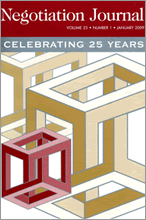
As the use of mediation continues to grow, researchers continue to examine what makes mediators effective and what the impact of mediation is on parties in dispute. Four articles in the July 2009 issue of Negotiation Journal provide an in-depth view of mediation effectiveness, with some interesting findings.
In the first article, Stephen Goldberg, Margaret Shaw, and Jeanne Brett follow up Goldberg and Shaw’s two previous articles on mediator effectiveness entitled “Secrets of Successful Mediators.” In this third installment, they look specifically at the effectiveness of former judges as mediators, asking “What Difference Does a Robe Make? Comparing Mediators with and without Prior Judicial Experience.” The authors report that the ability to gain parties’ confidence was especially critical to judge mediators, while judge mediators were less reliant than non-judge mediators on their mediation process skills. Unsurprisingly, Goldberg, Shaw and Brett found that judge mediators were especially prized for their ability to evaluate the strength of parties’ cases.
Also in this issue, Jean Poitras queried disputants themselves to ask “What Makes Parties Trust Their Mediator?” Like Goldberg, Shaw, and Brett, Poitras reports that such personal characteristics such as warmth and likability are key. He also reports that the perception of any kind of bias in favor of the other side in a dispute can be lethal to a party’s willingness to trust a mediator.
In their study of mediated versus litigated custody arrangements, “Assessing Empowerment in Divorce Mediation,” Jo Daugherty Bailey and Dawn McCarty used an increase in the non-custodial parents’ visitation time as an indicator of increased empowerment and found that, indeed, parents who mediated custody had more equitable and creative custody arrangements and were thus more empowered.
Enhancing mediation effectiveness is also the topic of Samatha Hardy’s teaching note. In “Teaching Mediation as Reflective Practice,” she describes how teachers can make students more reflective and effective mediators by modeling such behaviors in the classroom.
In their article entitled “An Exploration of a Model of Social Networks and Multilateral Negotiations,” Bruce Money and Chad Allred describe an experiment examining the impact of social networks and clique formation on complex multi-party negotiations. They report that negotiators’ perspectives of their own and other parties’ effectiveness at coalition-building have unique effects on the integrative, problem-solving approaches used in the process and on the negotiators’ satisfaction with outcomes.
Jason Enia contributes a case analysis to the July issue of Negotiation Journal. In his article, “Sequencing Negotiating Partners,” he looks at the process of negotiating free trade agreements. Specifically, he contrasts the strategies of Japan and South Korea in their first free trade negotiations, concluding that there are advantages to negotiating politically easier deals ahead of more difficult ones.
Finally, in this issue’s column, Chris Guthrie sings the praises of curiosity. Negotiators should “Be Curious” because curiosity is the first step towards understanding the other party’s aims in any negotiation…keeping you one step ahead of the competition. And if you’re not naturally curious, Guthrie tells us, don’t worry: curiosity can be cultivated.
For more information on Negotiation Journal, including how to subscribe, please visit http://pon.harvard.edu/publications/negotiation-journal/.





No Responses to “Negotiation Journal July issue focuses on mediation, multi-party negotiation, trade negotiations and curiosity”